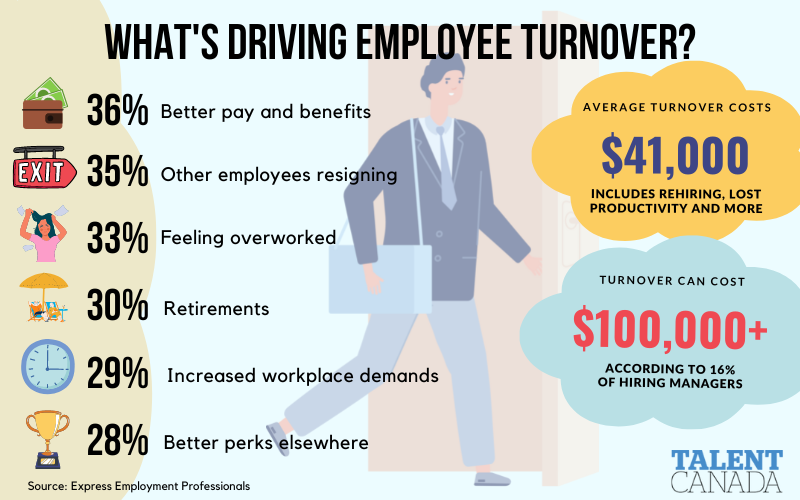

Features
Retention
Workforce Statistics
Turnover continues to plague Canadian employers, one-third report increase over last year: Survey
December 1, 2022
By
Talent Canada
 Photo: Adobe Stock
Photo: Adobe Stock Turnover is continuing to cause headaches for Canadian employers, with more than one-third of companies reporting an increase in exits compared to last year, according to a new study.
The survey, from The Harris Poll and commissioned by Express Employment Professionals, found 35 per cent of respondents were experiencing higher turnover. That’s a significant rise from the nearly one-quarter (24 per cent) who said the same thing in 2021.
According to the survey, employee turnover costs companies an average of over $41,000 each year (including the cost to rehire, lost productivity and more). Those costs are even higher for some employers, with more than 1 in 10 hiring managers (16 per cent) reporting $100,000 or more per year in turnover expenses.
Main drivers of turnover
For companies with increased turnover this year, the main causes identified include:
- better pay and/or benefits offered elsewhere (36 per cent)
- employees resigning (35 per cent)
- employees feeling overworked (33 per cent)
- retirements (30 per cent)
- increased workplace demands (29 per cent)
- better perks elsewhere such as summer Fridays and unlimited vacation days (28 per cent).
Impact on remaining employees
Turnover does more than impact a company’s finances; it can also impact employees who remain with a company.
Two-thirds of companies agree that employee turnover places a heavy burden on existing employees (64 per cent). This is especially the case with large employers with 100 or more employees (75 per cent) compared to small businesses with fewer than 10 employees (50 per cent).
With the added complexity of the current labour shortage, companies are having to lean heavily on their current employees, the company said in a press release.
 “The costs of employee turnover can be absolutely devastating,” said Brent Pollington, an Express franchise owner in Vancouver. “Companies have been innovating and adapting, but job seekers keep increasing their demands. Businesses are more willing to hire for aptitude and motivation and then train for skill and knowledge but, as a result, the learning curve is great and longer tenure is required for the business to see a return.”
“The costs of employee turnover can be absolutely devastating,” said Brent Pollington, an Express franchise owner in Vancouver. “Companies have been innovating and adapting, but job seekers keep increasing their demands. Businesses are more willing to hire for aptitude and motivation and then train for skill and knowledge but, as a result, the learning curve is great and longer tenure is required for the business to see a return.”
Pollington says companies need to take a serious look at what can help them stem the exodus of workers if they want to avoid costly turnover.
“Turnover costs much more than a salary increase, so companies may need to open their pockets more than they might want,” said Pollington. “However, job seekers need to be aware that higher salaries can come with greater expectation on the employee and can make the barrier to entry greater for job seekers, further increasing the divide between job seekers and employers.”
But salary isn’t the only reason for turnover.
“The other main cause of turnover is lack of leadership and poor company culture,” said Pollington. “Leaders need to find better ways to engage their employees. There are so many factors other than compensation that lead to good company cultures.”
It’s no surprise workers are willing to jump for better opportunities, Express Employment International CEO Bill Stoller said.
“A well-rounded workforce is one that stays,” he said. “The goal of any employer should be to create such a healthy company culture that top talent will turn down other job offers. It may just be the key to stopping future turnover.”
Survey methodology
The survey was conducted online within Canada by The Harris Poll on behalf of Express Employment Professionals between May 3-23, 2022, among 504 Canadian hiring decision-makers (defined as adults ages 18+ in Canada who are employed full-time or self-employed, work at companies with more than one employee and have full/significant involvement in hiring decisions at their company).
Data were weighted where necessary by company size to bring them into line with their actual proportions in the population.
Print this page